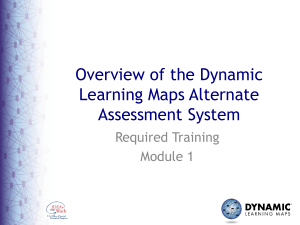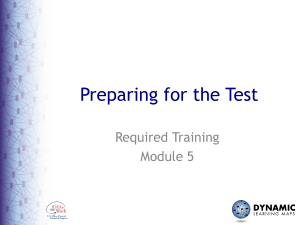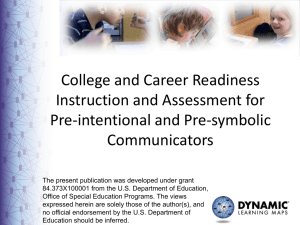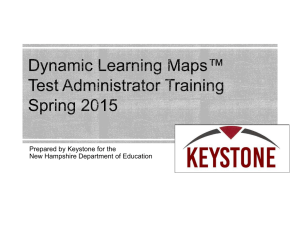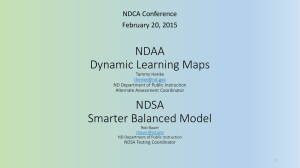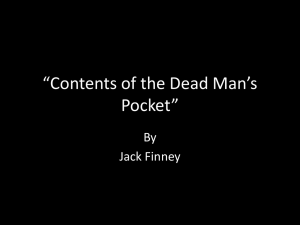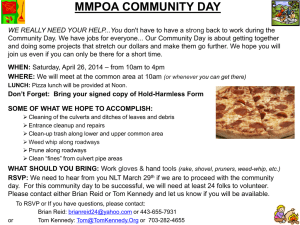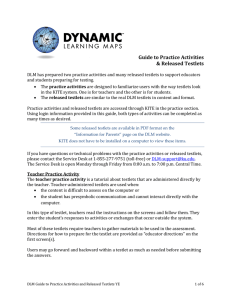DLM Consortium Monthly Conference Call
advertisement
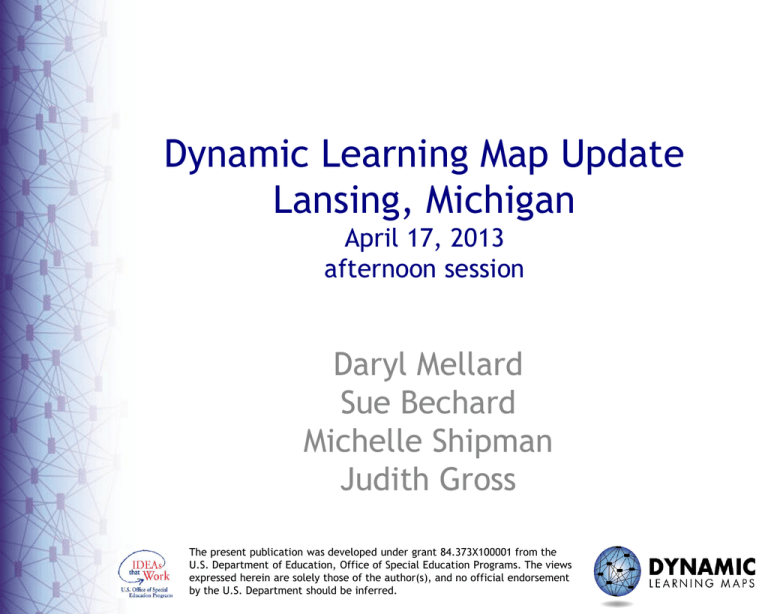
Dynamic Learning Map Update Lansing, Michigan April 17, 2013 afternoon session Daryl Mellard Sue Bechard Michelle Shipman Judith Gross The present publication was developed under grant 84.373X100001 from the U.S. Department of Education, Office of Special Education Programs. The views expressed herein are solely those of the author(s), and no official endorsement by the U.S. Department should be inferred. DLM 2012/2013 update Depth of Knowledge Taxonomy • Extensions Learning Maps • Claims, conceptual areas • Foundation nodes First Contact Survey Instructionally Relevant Testlets • Testlet development • Example items • Technology Enhanced Templates DLM Future Activities DEPTH OF KNOWLEDGE DLM Depth of Knowledge Taxonomy Process Pre-intentional Attend Respond Replicate Remember Understand Apply Analyze Evaluate Create Definitions Behavior reflects a general state but does not reflect intentional behavior. Intent is inferred by others (e.g., teachers, parents) through facial expressions, movements, or sounds. Orients to objects, people or activity. Indicates selective attention to stimuli in the academic learning environment. Intentional response using any mode of expression. Indicates joint attention to materials and activities in the academic learning environment. Perform rote task in familiar or practiced context. Retrieve relevant knowledge from long-term memory in a novel context. Construct meaning from instructional messages, including oral, written, and graphic communication. Carry out or use a procedure in a given situation. Break material into its constituent parts and determine how the parts relate to one another and to an overall structure or purpose. Make judgments based on criteria and standards. Put elements together to form a coherent or functional whole; reorganize elements into a new pattern or structure. What’s new? Process Definitions Pre-intentional Behavior reflects a general state but does not reflect intentional behavior. Intent is inferred by others (e.g., teachers, parents) through facial expressions, movements, or sounds. Attend Orients to objects, people or activity. Indicates selective attention to stimuli in the academic learning environment. Respond Intentional response using any mode of expression. Indicates joint attention to materials and activities in the academic learning environment. Replicate Perform rote task in familiar or practiced context. Remember Retrieve relevant knowledge from long-term memory in a novel context. LEARNING MAPS Making Connections Claims Conceptual Areas EE Map What are claims? • Communicate the goals we have for student learning • Provide a framework for organizing teaching and learning both within and across grades • Represent the knowledge, skills, and abilities that support understanding and proficiency Making Connections Claims Conceptual Areas EE Map What are conceptual areas? • Areas that are organized around common cognitive processes. • EEs (tied to nodes) are embedded within conceptual areas. • May be organized/structured differently in mathematics and ELA. Claims and Conceptual Areas: ELA Claim Conceptual Area EE Count Claim 1 Students can comprehend text in increasingly complex ways 1. Determining Critical Elements of Text 66 2. Constructing Understandings of Text 77 3. Integrating Ideas and Information from Text 91 Claim 3 Students can communicate for a range of purposes and audiences 1. Using Language to Communicate with Others 79 2. Clarifying and Contributing in Discussion 72 Claims and Conceptual Areas: ELA Claim Conceptual Area EE Count Claim 2 Students can produce writing for a range of purposes and audiences 1. Using Writing to 2. Integrating Communicate Ideas and Information in Writing 47 35 Claim 4 Students can engage in research/inquiry to investigate topics and present information 1. Using Sources and Information 18 2. Collaborating and Presenting Ideas 22 Claims and Conceptual Areas: Mathematics Claim Conceptual Area EE Count Claim 1 Number Sense: Students demonstrate increasingly complex understanding of number sense. 1. Understand 2. Compare, number compose, and structures decompose (counting, numbers and place value, sets fraction) 21 19 Claim 2 Algebraic and functional reasoning: Students solve increasingly complex mathematical problems, making productive use of algebra and functions. 3. Calculate 1. Use operations accurately and and models to efficiently using solve problems simple arithmetic 19 25 2. Understand patterns and functional thinking 12 Claims and Conceptual Areas: Mathematics Claim Conceptual Area EE Count Claim 3 Geometry: Students demonstrate increasingly complex spatial reasoning and understanding of geometric principles. Claim 4 Measurement Data and Analysis: Students demonstrate Increasingly complex understanding of measurement, data, and analytic procedures. 1. Understand and use geometric properties of two- and threedimensional shapes 1. Understand 2. Represent and and use interpret data measurement displays principles and units of measure 23 2. Solve problems involving area, perimeter, and volume 15 23 16 Foundation Nodes on the Dynamic Learning Map • Currently have 150 foundation nodes on the map. • They cover: – Pre-intentional – Attend – Respond • They are not linked to one academic area but are foundational to all FIRST CONTACT SURVEY STUDENT CHARACTERISTICS First Contact Survey • • • • • • • • • Teacher demographics Student demographics Classroom setting Sensory capabilities (accessibility needs) Motor capabilities Computer access Communication Academic skills Attention First Contact Sample: Disability Type 45.0 41.0 40.0 35.0 30.0 26.9 Percent 24.5 25.0 20.0 15.0 10.0 5.0 .3 1.0 .3 .3 0.0 Disability Type 1.0 2.8 1.4 .3 Language Use Pre – symbolic Language Users Emerging Symbolic Users Symbolic Language Users Kearns, J., Kleinert, H., Harrison, B., Sheppard-Jones, K., Hall, M., Jones, M. (2010). What does ‘ college and career ready’ mean for students with significant cognitive disabilities? Lexington: University of Kentucky. First Contact Sample: Reading 0 5 10 15 20 Does not read any words when presented in print or Braille (not including environmental signs or logos) 35 17 Elem 13 Middle High Above first grade level to second grade level 18 Above second grade level to third grade level 18 Above third grade level 30 19 Reads only a few words or up to pre-primer level Primer to first grade level 25 15 10% of 1% Judith Gross & Michelle Shipman INSTRUCTIONALLY RELEVANT TESTLETS Testlet Development 1 Essential Element 2 Dynamic Learning Map 3 Essential Element Concept Map 4 Testlets at 5 levels 5 Iterative Review 1 Essential Element Step 1: Aligning the Essential Element Common Core State Standard Essential Element 2 Dynamic Learning Map Step 2: Mapping the Essential Element Node Essential Element Analyze connections Match Node Node Node Fractions M.EE.3.NF.1-3 Differentiate a fractional part from a whole Feelings of Characters ELA.EE.RL.3.3 Identify the feelings of the characters in a story Character Responds to a Challenge EE.RL.6.3 Can identify how a character responds to a challenge in the story 3 Essential Element Concept Map • • • • • • Step 3: Completing the Essential Element Concept Map Essential Questions Vocabulary Nodes Questions to Ask Misconceptions/Errors Accessibility/Barriers Essential Element Concept Map 4 Testlets at 5 levels Step 4: Creating Instructionally Relevant Testlets 4 Testlets at 5 levels Step 4: Creating an Instructionally Relevant Testlet Type Connect the map… …to the items developed. Initial Precursor Behavior Testlet a Distal Precursor Behavior Testlet b Proximal Precursor Behavior Testlet c Target Behavior Testlet d Behavior Testlet e Successors 5 Iterative Review Step 5: Iterative Review Process Internal: • Item development teams • Editing content and graphics • Sensitivity and bias • Accessibility External: • State visits Fractions From Foundation to 4th grade Essential Element Concept Map • M.EE.3.NF.1-3 – Differentiate a fractional part from a whole – – – – – Math Essential Element Grade 3 Numbers and Fractions Standards 1-3 • Covers 5 levels from Foundational Skills (Initial precursors) through 4th Grade (Successor skills) M.EE.3.NF.1-3 Differentiate a fractional part from a whole Initial Precursors F-62 Attend F-13 Recognize some Distal Precursors F-38 Explain set F-69 Recognize wholeness F-84 Recognize separateness Proximal Precursors F-59 Explain sub-set F-72 Partition sets F-2392 Partition length M-248 Partition shapes Targets M-561 Explain part-whole relationship M-2411 Explain fraction Successors (M.EE.4.NF.3) M-2537 (area), M-2538 (length), M-2539 (sets) - Identify whole M-2350 (area), M-2349 (length), M-2348 (sets) - Identify half Another related fraction EE M.EE.4.NF.1-2 Identify ½ and ¼ Initial Precursor Testlet Henry and Mudge are Happy – ELA.EE.RL.3.3 Identify the feelings of characters in a story. – 3rd grade – Initial precursor level testlet – Task 1 • General task and blind/low vision task • F-18 Seeks attention of others • Precursor of ELA-766 – Task 2 • General task • F-766 Can identify feeling states in self TEACHER DIRECTIONS You are going to read the familiar story, Henry and Mudge, with the student. You will record the student’s response when you: • show the student a favorite object OR • show the toy you have used to represent Mudge Put the object out of the student’s sight or reach, but within your reach. After you finish reading, you will ask the student a question and record the response. Henry and Mudge are Happy DLM Henry was a boy. Henry wanted a dog. TEACHER DIRECTIONS (general) Stop reading. Present the object just out of reach but within sight of the student. Move the item in an effort to attract the students attention, but do not speak or otherwise prompt. Record the student’s response (check only one). Communicates desire to have the object by: Reaching for object Gazing/looking at object Vocalizing Using other gesture or indicator Smiles, laughs or shows excitement Whines, cries, or appears frustrated No response TEACHER DIRECTIONS (blind/low vision) Stop reading. Allow the student to touch, smell, or otherwise interact with the object for a moment. Remove the item and do not speak or otherwise prompt. Record the student’s response (check only one). Communicates desire to have the object by: Reaching for objects or searching with hands Turning to you and reaching Vocalizing Using other gesture or indicator Smiles, laughs or shows excitement Whines, cries, or appears frustrated No response Mom and dad wanted to make Henry happy. They got him a dog. Henry named him Mudge. Henry loved Mudge. Henry was a happy boy. Mudge was a happy dog. TEACHER DIRECTIONS Ask the student, “Henry and Mudge are happy. Are you happy?” Record the student’s response (check only one). Clear yes or no response by: Vocalization Head nod/shake Other gesture Indicated happiness (laughter, smile) Indicated displeasure (grimace, frown, grunt) No response Initial Precursor Testlet Aunt Polly – ELA.EE.RL.6.3 Can identify how a character responds to a challenge in the story – 6th grade – Initial precursor level testlet – Familiar text • Common Core State Standards English Language Arts Text Exemplars • The Adventures of Tom Sawyer – Task 1 and Task 2 • F-11 Can demonstrate understanding of action words. TEACHER DIRECTIONS You are going to read the familiar story, Aunt Polly, with the student. You will record whether the student indicates recognition or understanding of the repeated line during and after the story. Aunt Polly makes Tom do different things. Each of them is a common action. As you read each page that begins, “Aunt Polly makes Tom…”: • model the gesture, • point to the symbol, or • model using the voice output device that matches the action. As you read each page that begins, “Tom hates…” pause at least 10 seconds to give the student a chance to: • initiate the gesture, • point to the symbol, or • access the single message voice output device. If the student does not initiate without support after 10 seconds, model the use of the gesture, symbol or switch. If the student does not respond after the model, use a prompt. Aunt Polly DLM This is Tom's Aunt Polly. Aunt Polly makes Tom wash. Tom hates to wash. TEACHER DIRECTIONS Describe how the student responded after you read the word, “wash” (check only one). Independently initiated use of: Gesture Symbol Voice output device After presented with a model of the desired behavior, the student used: Gesture Symbol Voice output device After prompting, the student used: Gesture Symbol Voice output device Smiled, laughed, vocalized or otherwise indicated enjoyment Protested, cried, or otherwise indicated displeasure No Response Aunt Polly makes Tom comb his hair. Tom hates to comb his hair. Aunt Polly makes Tom eat at the table. Tom hates to eat at the table. Aunt Polly makes Tom go to sleep. Tom hates to go to sleep. TEACHER DIRECTIONS Describe how the student responded after you read the word, “sleep” (check only one). Independently initiated use of: Gesture Symbol Voice output device After presented with a model of the desired behavior, the student used: Gesture Symbol Voice output device After prompting, the student used: Gesture Symbol Voice output device Smiled, laughed, vocalized or otherwise indicated enjoyment Protested, cried, or otherwise indicated displeasure No Response Tom hates to do lots of things. Aunt Polly makes Tom do them anyway. ITEM TEMPLATES FOR TECHNOLOGY ENHANCED ITEMS Boardmaker Studio Templates • Accessibility features – One and two-switch scanning – Click to place • Extensively researched – Informs design of DLM technology enhanced item templates DLM Editor Templates • Accessibility features – One and two-switch scanning – Click to place • Delivery – HTML packages will upload into Content Builder • Crosswalk – Studio items will transition into Editor templates Sorting Sorting Hot Text Ordering Labeling Matching DLM FUTURE ACTIVITIES DLM Test Development Research Activities: 2013/2014 Study / Test Development Phase Cognitive Labs/ Sample Items Internal Data Test #1 Internal Data Test #2 Dates Purposes / Research Questions May-June To evaluate: 2013 Technology enhanced item template design Student-technology interface Item administration processes Response processes Mid-May 2013 Sept 2013 (25 specific research questions have been drafted.) Simulation – integration of data systems in KITE Full test of KITE functions for the pilot in Oct Next Steps Identify items Identify and recruit sample Finalize data collection tools Amend IRB Logistics Activities: 2013/2014 Study / Test Development Pilot Test/fixed form Sample of Testlets Field Test /adaptive Rolling Field Test Dates Purposes / Research Questions October · To evaluate student-technology 2013 interface and testlet (moved administration processes from · To obtain initial psychometric July information on testlet 2013) functioning · To evaluate point of entry identification strategies · Post administration survey Winter 2013May 2014 · Statistical analysis to facilitate adaptive function · Increase and evaluate additional accommodations and access strategies · Include some students not eligible for AAS and compare (cont.) Next Steps (same logistics as presented previously) Recruit 1800 students in 3 grade levels: · 600 students in 3-4, · 600 students in 7-8 · 600 students in 10-11 Create items in 2 conceptual areas: · 1 ELA, 1 math: · 3 testlets each in ELA and Math for each grade band = 18 testlets Develop specifics on field test logistics THANK YOU! For more information, please contact: dlm@ku.edu or Go to: www.dynamiclearningmaps.org The present publication was developed under grant 84.373X100001 from the U.S. Department of Education, Office of Special Education Programs. The views expressed herein are solely those of the author(s), and no official endorsement by the U.S. Department should be inferred.
